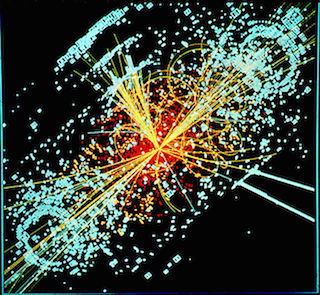Super-Collider
 At time
t
=
0
a particle is at point
0
on the real line. At time
t
=
1
, the particle divides into two and instantaneously after division, one particle moves one unit to the left and the other moves one unit to the right. At time
t
=
2
, each of these particles gets divided into
2
and one of the two new particles move to the right by 1 unit and the other moves to the left by 1 unit. Whenever two particles meet on the real line they annihilate (destroy) each other completely leaving not a single trace behind.
At time
t
=
0
a particle is at point
0
on the real line. At time
t
=
1
, the particle divides into two and instantaneously after division, one particle moves one unit to the left and the other moves one unit to the right. At time
t
=
2
, each of these particles gets divided into
2
and one of the two new particles move to the right by 1 unit and the other moves to the left by 1 unit. Whenever two particles meet on the real line they annihilate (destroy) each other completely leaving not a single trace behind.
How many particles will be there at time t = 8 1 9 3 ?
Image credit: Wikipedia CERN
The answer is 4.
This section requires Javascript.
You are seeing this because something didn't load right. We suggest you, (a) try
refreshing the page, (b) enabling javascript if it is disabled on your browser and,
finally, (c)
loading the
non-javascript version of this page
. We're sorry about the hassle.
4 solutions
Discussions for this problem are now closed
The Sierpinski triangle is an awesome way to visualize this.....nice job!
This solution is under construction and for now it will only serve as a hint,bookmark it if you want a full solution
They best way to visualize this is to play this game with a few checkerboard pieces or anything of that sort.
You will notice that the number of particles will always be 2 whenever t = 2 k for any value of k .
Here 8 1 9 3 = 2 1 3 + 1 ,SO after that many time steps, the number of particles will be 4 .
An easy approach is to show that the problem is equivalent to the case where particles split, but do not annihilate each other. We then just want to check the parity of the number of particles at each point. This also generalizes for all time t .
Sir,do you mean considering the particles that meet to be just one particle because otherwise the parity will always be even as they are being divided into half??
Ignore the condition that the particles annihilate each other (we will end up with 2 t particles). Show that if we count the number of particles at each point in modulo 2, then we have an equivalent scenario to the one you described.
@Calvin Lin – Yes sir ,it does happen like that,odd means a particle is present even means none are present.Sort of like a bijection.
We just apply condition up to time=16. We can see that, every time when time is 2^n(n should be integer and not for n=0) it will have 2 particles only. And it should be when time is 2^n+1(n not equal to 0) will have four particles. So, at time 2^13=8192 it have 2 particles. That's why at time 8193(2^13+1) there will be 4 particles...Thank you.
I think that after t=3 , the number of particles will always be 4.So that was the solution! (IDK if it is the right way to do it )
That is not a true statement.
It's false. For example, for t=4, the number of particles will be 2, or for t=7 the answer would be 8.
No. it's 4
When you draw it's the Sierpinski triangle! And it makes a lot of sense:
By graphing the particles against time it sorts out that this "duplications" are very similar to the construction of Pascal's Triangle. It is known that Pascal's Triangle modulo 2 is the Sierpinski Triangle. After that it's easy: these "big empty triangles" begin in every 2^n row.
8193 = 8192 +1 = 2^13 +1
So t=8193 is the first duplication of two separated particles (with no annihilation, obviously)
2*2 = 4